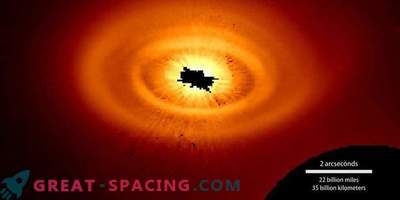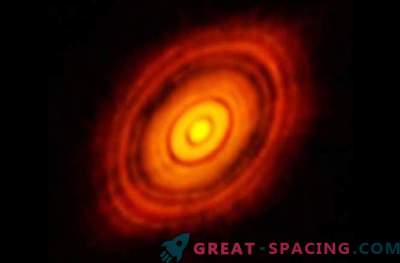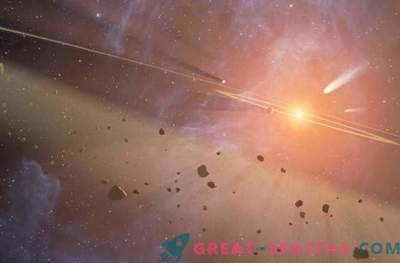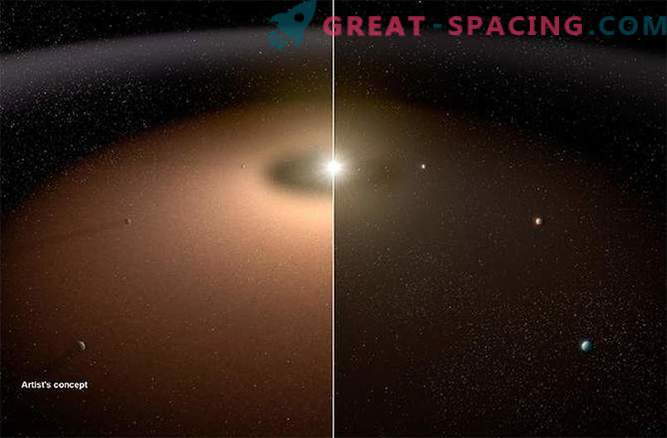
Dust penetrates everywhere, especially its many around young stars. But when it comes to the presence of dust in the interplanetary space around mature stars such as the Sun, it turns out that they provide the best conditions for searching and direct observation of exoplanets.
“Dust is a stick at both ends when it comes to observing faraway planets,” says Brtran Mennesson of NASA's Jet Propulsion Laboratory in Pasadena, California. "The presence of dust may indicate the presence of planets, but too much dust may not allow them to be observed."
Using the Keck Interferometer (formerly a NASA project), along with two twin 10-meter telescopes for optical infrared observations installed at the Keck Observatory, which is located on the peak of Mauna Kea, Hawaii, during 2008-2011. allowed to study 50C-like stars, and it was found that about half of them have a low level of warm dust. The results of this study, as well as the implications for exploring alien worlds, will be published in the Astrophysical Journal online publication on December 8th.

Two 10-meter twin telescopes installed in the Keck Observatory
Today, many exoplanets can be directly observed from ground-based and space observatories, but these exoplanets have cold orbits that are far removed from the parent star. Using a combination of advanced instruments and modern image processing techniques can block the glare of the target star (which the exoplanet could otherwise hide from our view) and discover new alien worlds (big gas giants). However, in order to see the small rocky worlds inside the habitable zone of stars, another technological breakthrough must occur in order for these compact worlds to be discerned. Once this is achieved, astronomers will have the chance to directly observe small “residential” exoplanets.
"If we do not block the glare from the star, we will be blinded and will not be able to distinguish the planets," said co-author Raphael Millan-Gabe of the California Institute of Technology, located in Pasadena, who often collaborates with NASA to visualize exoplanets.
The habitable zone around the star is a region in which water can remain in liquid form (if any) on the surface of a small rocky world. At the same time, the temperature of this world should be “not too hot,” but also “not too cold.” Therefore, this region is often called the “Goldilocks Zone”. The Earth is located in the center of the Goldilocks Zone of our star, and is the only known planet in the Universe that has life. That is why liquid water is a critical condition for the evolution of life in the form in which we know it.
But in trying to better understand the habitable zones around other stars, warm dust can be a serious obstacle. While its presence may be building blocks for the rocky worlds, the dust itself may reflect light from these exoplanets, thereby increasing the complexity of their direct observation.
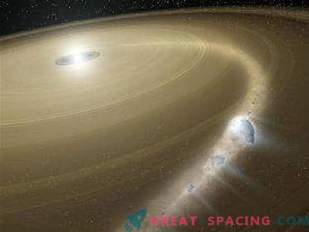
Material "flows" from colder dust belts into a warm belt.
Using data from the Keck Interferometer, the researchers found that stars, such as the Sun, have cold dust belts in their remote regions, but other than that they also have warm dust belts in their residential areas. On the other hand, if the star does not have a cold belt of dust, then it does not have a warm belt. This is the first time that such a pattern has been determined. Thus, stars without a cold belt of dust have less warm dust and, therefore, are the best candidates to search for extraterrestrial worlds.
“We want to avoid searching for planets that are“ buried in the dust ”,” said Mennesson. "Dust glows in the infrared and reflects the visible starlight, so it blocks the light of the planet."
This pattern also explains why all mature star systems have a warm dust belt. The dusty interplanetary environment surrounding the young stars is mixed - the remnants of the formation of planets, the planets themselves, comets and asteroids raise a lot of dust. But in mature star systems like our solar system, this warm dust settles and forms planets in stable orbits. Thus, the researchers found a dynamic connection between the external (cooled) and internal (warm) dust belt around mature stars.
"The outer belt somehow transfers the material to the inner warm belt," said Jeff Bryden of the Jet Propulsion Laboratory and co-author of the study. "This transfer of matter can be explained by a smooth transition of the substance from the outer boundaries to the inside, or at the expense of a larger number of comets."




